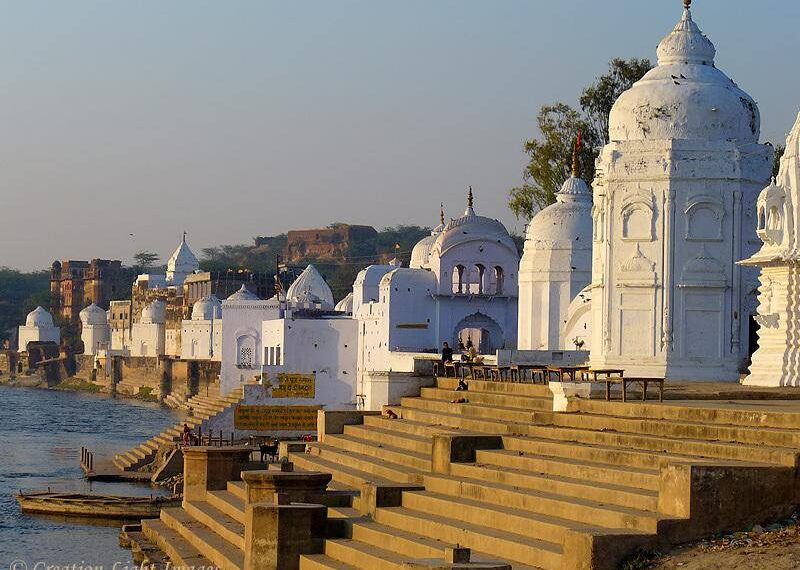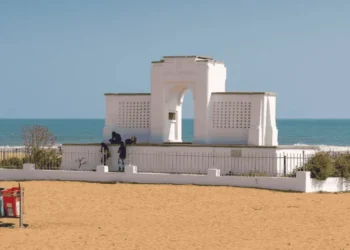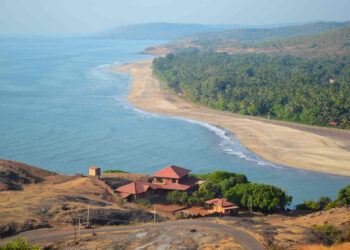Bateshwarnath Dham is a revered shrine in Bateshwar village, Agra district, Uttar Pradesh, resting on the banks of the Yamuna River. Dedicated to Lord Shiva, he is also known as Bateshwarnath Mahadev, who is believed to grant the wishes of those who worship him sincerely. The ancient temple stands near the river, honoring Shiva as the protector of this sacred land. It is also believed that Parvati, in her form as Gauri, accompanies him here.
History of Bateshwarnath Dham
The Bateshwarnath Dham is believed to have been established about 400 years back by Raja Badan Singh Bhadauria, a king of the Bhadawar house. Agra, connected to ancient Hindu stories and Krishna’s birth in nearby Mathura, is a sacred city. Local tradition holds that Shiva rested under a banyan tree here and blessed the land with his presence. Historical records list it as a group of 101 Shiva temples, called a dham, with some dating back to the 8th century. The name Bateshwarnath comes from “Bat Ishwar,” meaning Banyan Lord.
The temple is built on level ground and can be reached by climbing twelve stone steps. Writers from the British period in the 1800s recorded that it attracted large crowds of devotees. After India gained independence in 1947, a local trust took responsibility for its management. Renovations which was carried out in the 1980s preserved the temple’s original ancient design. For generations, saints have praised Lord Shiva here, which helped the temple gain wide recognition. Even today, many pilgrims visit this sacred place in Agra.
Legends of Bateshwarnath Dham
The temple is linked to many local stories about Lord Shiva. One says that long ago, Shiva sat beneath a banyan tree in Bateshwar, blessing the spot with his divine presence. Those who come here to pray with sincerity are believed to have their wishes fulfilled. The name Bateshwarnath, meaning “Lord of the Banyan,” comes from this association. Devotees hold that prayers made with a pure heart bring health, wealth, and peace.
Another story speaks of couples without children who visited the temple, offered bells to Shiva, and were later blessed with children. Locals also tell of other miracles, such as finding relief from troubles or receiving guidance after earnest prayers. The nearby Yamuna River, which is said in some spots to flow backward, is also thought to carry Shiva’s hidden energy. Some even say that dacoits once came to the temple to offer bells after their deeds, believing Shiva would protect them.
It is also said that offering bells to the shivling seven times can make wishes come true. Many visitors feel that the temple’s atmosphere itself carries Shiva’s protective power, making it a place of comfort and care. On Shivratri, devotees believe that Shiva’s presence becomes especially strong here, drawing pilgrims from near and far.
Rituals and Festivals
The temple comes alive for festivals. Shivratri, in February, is big, with all-night songs and milk offerings. Sawan, in July or August, honors Shiva with daily lamp offerings. The name Bateshwarnath Mahadev itself means that no wish goes unfulfilled here. Devotees feel a deep sense of peace as soon as they enter the temple. Many come to pray for marriage or children, and when their wishes are granted, they offer belpatra, Gangajal, milk, and bells to Baba. Even a simple pot of water is said to please him.
There is also a tradition of offering silver items like bells, snakes, and tridents to Baba Bateshwarnath. Devotees believe that silver offerings quickly win his favor, but Baba is pleased even with just a pot of water. Diwali Mela, in October or November, sees the temple decorated with flowers. Shivratri’s songs fill the yard with faith. The Yamuna ghat, said to wash sins, pulls crowds nearby. Folks offer milk, bel leaves, coconut, and silver bells.
Information for Travelers
Hours and Entry: Open every day, summer: 5:00 AM to 9:00 PM; winter: 5:30 AM to 8:30 PM; Mondays till 10:00 PM. It’s free to go in, but prayers cost ₹20–100. No pictures in the main hall. One special feature of this temple is that even those who do not wish to enter can still see the shivling from outside.
However, only those wearing traditional Indian clothing like dhoti or saree are allowed near the shivling. Inside the temple grounds, behind the main sanctum, there are several smaller shrines. Here, akhand jyots (eternal lamps) burn continuously, fueled by desi ghee. When their wishes are fulfilled, devotees return to light a lamp, which can cost anywhere from one and a quarter rupees to one lakh rupees.
How to Get There:
Air: Pandit Deen Dayal Upadhyay Airport is about 83 kilometers off, with flights connecting to Delhi (around 1 hour) and Mumbai (around 2 hours). Taxis take approximately 2 hours to reach the temple.
Train: Bateshwar Halt Station is 5 kilometers off, with trains connecting to Agra (about 1 hour) and Etawah (about 2 hours). Auto-rickshaws are available for local travel.
Road: Bateshwar lies 70 kilometers from Agra via SH 62. Buses run between Agra and Bateshwar. Auto-rickshaws operate within the village.
Best Time to Visit: October to March is cool, 15–25°C. Weekdays are quiet. Shivratri and Sawan are busy, with 10,000–30,000 visitors, so come early.
Nearby Attractions:
Shauripur Jain Mandir: 5 km off, an ancient Jain shrine.
Taj Mahal: 70 km off, a Mughal tomb from 1648.
Agra Fort: 70 km off, a fort is from Akbar’s time.
Yamuna Ghat: Right there, a bath spot for prayers.
Final Words
Bateshwarnath Dham in Agra holds a very special place in the hearts of Shiva devotees, blending rich history with enduring faith for centuries. As a symbol of divine grace in Agra, the temple remains one of the cherished around the area, making it a must-visit temple in Uttar Pradesh.











